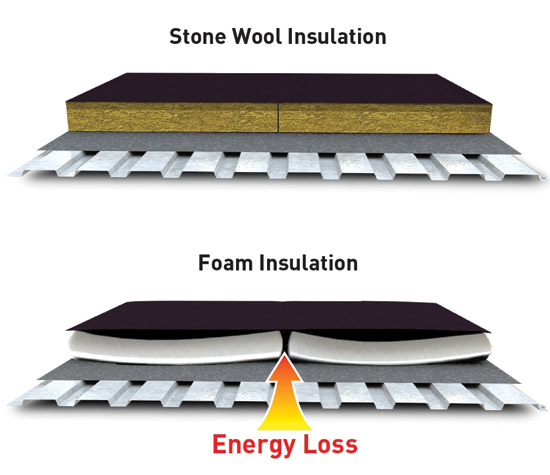Stone Wool Roof Insulation - A Climate Driven Choice
 |
Dimensionally stable stone wool insulation board prevents warping and gaps which promote energy loss. Image courtesy of ROXUL, Inc. |
Dimensional Stability
The term dimensional stability is generally defined as the material's ability to retain its original shape when subjected to external forces such as varying degrees of temperatures, atmospheric pressures, moisture content, and/or other external stresses. Dimensional stability in relation to thermal insulation is a physical characteristic that is sometimes overlooked when a designer or specifier is determining which type of insulation to use for a project, particularly on roofing applications. Neglecting the dimensional stability characteristics can potentially result in the reduction of the effective R-values, increased energy costs, increased environmental impacts (CO2), and the unexpected replacement of building materials due to stress and fatigue.
The dimensional stability of an insulation material is necessary for the faultless function of an insulation system. Dimensional changes in materials vary according to their physical properties. Thermal expansion coefficients express the rate at which materials shrink or expand when cooled or heated. Stone wool insulation has a much smaller thermal expansion coefficient than organic insulation materials such as foam plastics. Poor dimensional stability can cause shrinking, expansion, and buckling of a system's insulation. These actions can lead to thermal bridging, waterproofing breaches, and unpredictable insulation performance.
The most common dimensional change in building materials is created by temperature variation. In thermal insulation, the rate of this dimensional change due to temperature variation is based on three factors: the difference in temperature (ΔT), the coefficient of linear expansion (α), and the material length (l). Using these variables, stone wool insulation has been shown to move dramatically less when compared to the same sized common organic plastic insulation boards. Stone wool is also much closer to the coefficient of expansion of steel and concrete than the plastics, meaning that it will move more closely in line with those materials.
The other common dimensional change in many insulation products occurs due to aging. The molecular structure of foam insulation is initially unstable for a period of time after manufacturing and so there is high potential for shrinkage to occur. As this shrinkage is deemed to be an “acceptable practice” within the roofing industry, ASTM D2126 Test Method for Response of Rigid Cellular Plastics to Thermal and Humid Aging allows for a maximum shrinkage of 2 percent (length and width). In theory, this will reduce the insulation footprint covering a roof deck by 2 percent, thus allowing for increased heat loss and leaving the roofing membrane unsupported along insulation joints which increases the potential for damage. By contrast, studies have proven that stone wool insulation maintains its dimensions and its physical characteristics throughout a building's life cycle. By maintaining the material's original dimensions, full thermal insulation coverage is maintained and the roofing membrane service life is extended due to a lack of unnecessary stress and or fatigue.









